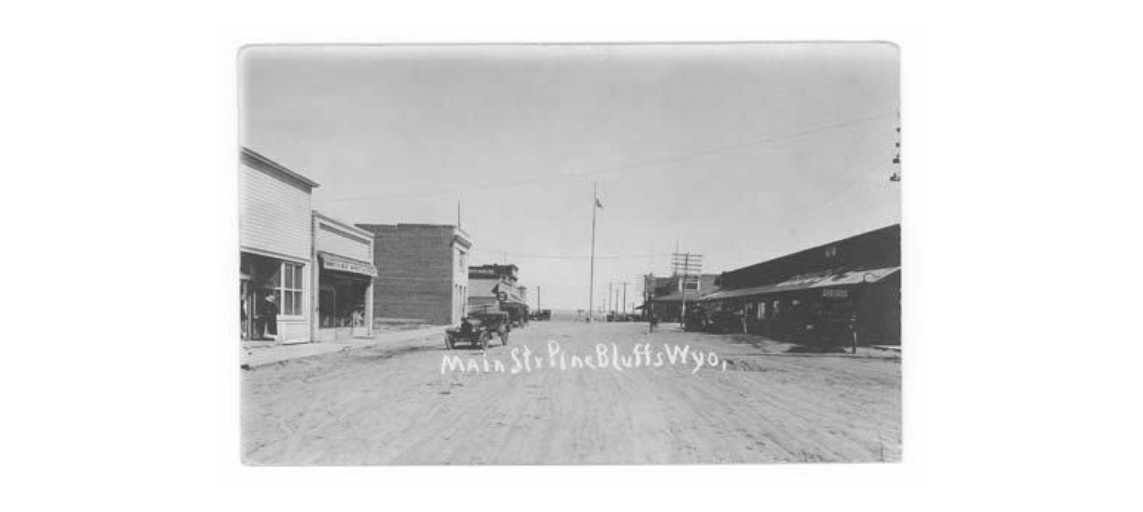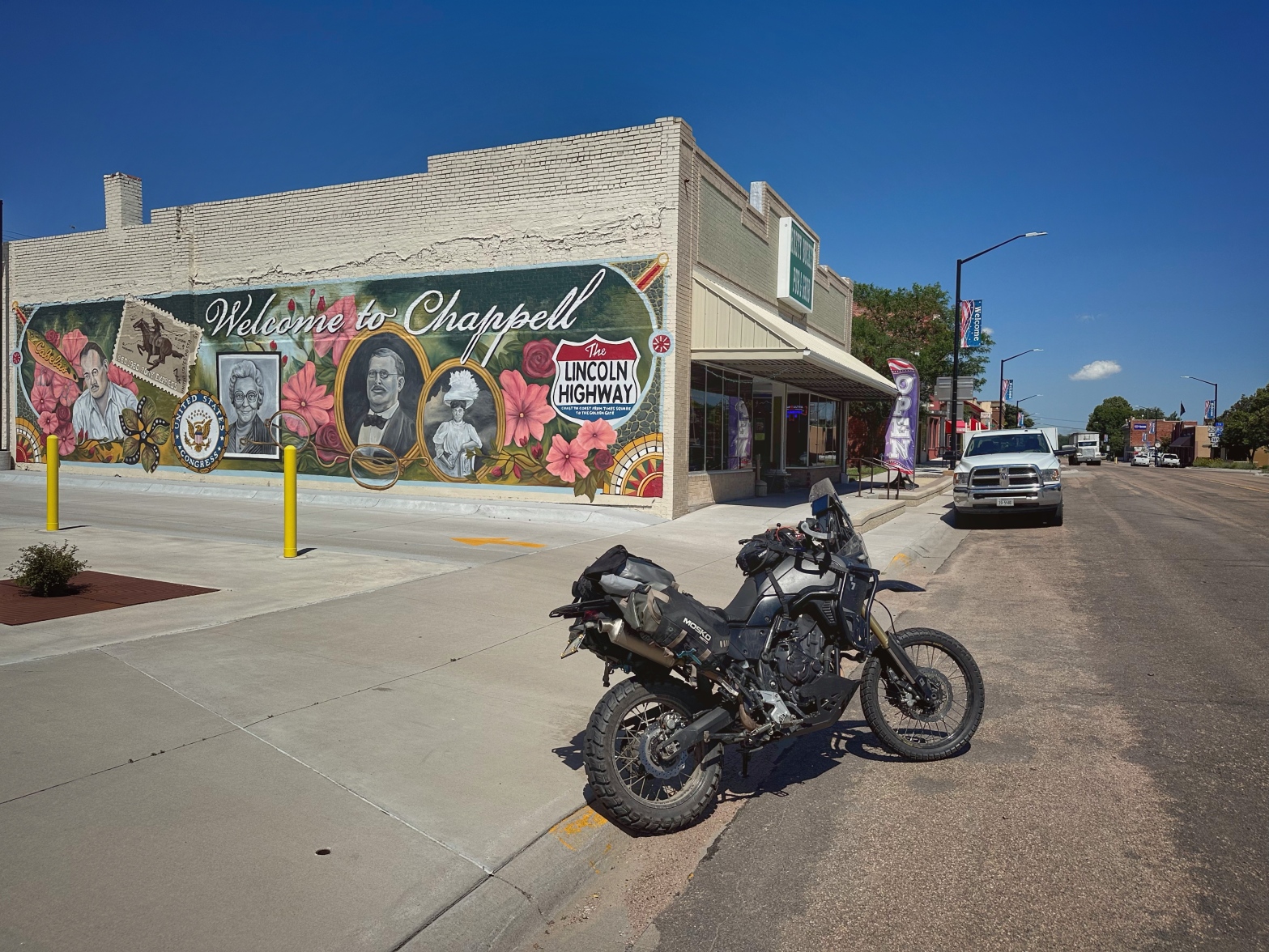June 5, 1903
(Layover in Cheyenne, WY)
“The next morning I washed and pinned up my rags as best I could and went out to replenish my wardrobe. I must indeed have been a tough-looking specimen the night before, because the first place I went into in the morning, a furnishing store, the dog growled at me savagely and disputed my entrance until called off by his owner.
It rained hard all day, and I remained in Cheyenne. while there I weighed myself and found that I was 12 pounds under my normal weight, the scales tipping at 141 pounds. I spent most of the day cleaning and fixing my wheel. Again, I aimed a hose on it, and after that I had to use a scraper and brushes before I could get down to work with a rag. I worked in the bicycle shop of G.D Pratt while there, and he extended me every courtesy.”
The bicycle shop is no longer there, a modern Wells Fargo bank building has replaced it.
There was only a handful of hotels in town in 1903, one of the better ones was the Pioneer, and it’s just a few hundred feet away, there is a good chance George stayed there.
His short walk across the W. 17th St to Capitol Ave, this would have been George’s view
…and today it hasn’t changed too much…
June 6, 1903
(Cheyenne, WY to Kimbell, NE)
“It was raining a little when I left Cheyenne, and the roads were too heavy to ride. I took to the railroad again, and the railroad ties were not much better than the road. For 43 miles I had to pedal.
If you ever went for a ride on a tandem and took your best girl, or some other fellow’s best girl, and she was a heavyweight, and about 30 miles from home she gave out and you had to do all the pushing to get home, you have a slight idea how I felt pushing the motor over the railroad ties.
I got to Egbert at 12:45 and had dinner at the section house there.
It is downhill all the way now. I have turned my back upon the Rockies and their grandeur and am nearing the great prairie lands. I can see Elk Mountain, which, with its snow-capped peak is a landmark for hundreds of miles around and in spite of the troubles I have had in the rocky country, I feel somewhat regretful at leaving it.
I do not know what troubles the prairies hold for me, and I shall miss the inspiration of the mountain air, the gorgeous view, and the coyotes and the glimpses of antelope that I caught a couple of times back near Laramie.
One new sight I do have is that of prairie dogs, and as they sit beside their holes and yelp at me I take several pot shots at them. They dodge into their burrows so quickly that you cannot tell whether you hit them or not: even when shot through the head or heart these creatures dodge into their holes to die.
It began to rain when I had gone a mile and a half from the station house, and, remembering my last experience with the rain and the gumbo mud, I turned back and waited at the telegraph operating room until the middle of the afternoon, when the rain slackened.
I got to Pine Bluffs on the state line between Wyoming and Nebraska, at 4:40 p.m. To furnish an idea of how rapidly I have come down it may be mentioned that at Pine Bluffs the elevation is 5,038 feet, and this is only 90 miles from the summit, where the elevation is 8,590 feet, a drop of 3,500 feet in less than 100 miles.
During my first few miles of travel in the state of Nebraska I was nearly killed by a freight train. l was riding alongside the track, close to the outer rail, where the dirt over the ties is level, and a strong wind was blowing in my face, so that I did not hear the rumble of the train.
Suddenly I heard the loud shriek of the whistle right in my ears. I looked back and the train was not more than 10 yards away. I just had time to shoot down the embankment, which, luckily, was only about four feet high at that place when the train ran past me.
As it was, the engineer had whistled “down brakes” and was scared himself. It is fortunate that I was not riding between the tracks at the time, or I would have surely had to sacrifice my bicycle to escape with my life. If it had been a fast passenger train and got that close to me, it would have hit me before I got out of the way.
This was worse than the mountains, for nothing that happened there came so near to causing heart failure. I got to Kimball, 65 miles from Cheyenne at 6:50 p.m.
Kimball NE
They told me there that the roads are good when it is not raining. I had to take their word for it, and conclude that I still carry some sort of a hoodoo with me, in spite of having shed my fancy waistcoat, for when I get into a region of good roads it rains and spoils them, and when it doesn’t rain I am in a district where the roads are never good.”
June 7, 1903
(Kimball to Ogallala, NE)
“On Sunday morning, June 7, I left Kimball, Nebraska, and made the biggest day’s run that I scored west of the Mississippi. It is a fine, grain-growing country that I rode through from Kimball, which is a prosperous town. For the first 12 miles the country was rolling and the roads sandy.
After that I found good hard roads all the way to Sidney, 35 miles from Kimball, and I made it in just three hours, reaching Sidney at 10:15.
I stopped for gas here and the adjacent building had this old Honda advertisement painted on its wall, made me wish I was on the Postie bike and its gargantuan 8 hp
When I rode into the place, which is a division town, I passed as tough a bunch of citizens as I met all through the West. They were young fellows loafing on a corner, and they tossed all manner of taunting comment at me, as if inviting trouble. I kept on my way without replying, which was wise, but not easy to do. After getting some gasolene(sic), I left at 10:30, and had no trouble making Chappell at 12:15, where I had dinner.
G.Wyman

I started again at 1:07 p.m., and quickly found that the good road was at an end. It became so bad, in fact, that I took to the railroad and rode the ties most of the way into Ogallala, 114 miles from Kimball.
Of this distance I made the first 65 miles in five hours, and had I had as good going in the afternoon as I had in the morning, I would have made 140 miles.
It began to rain shortly before I got to Ogallala, and I had to pedal over the last 15 miles. Of the 114 miles I made this day, 46 were ridden in the State of Colorado, for the railroad and road both put in a bend from Chappell southward to get to the South Platte River at Julesburg, Colorado and then the road follows the river valley back again into Nebraska; so that 46 miles was all of Colorado I saw.


This is the Railroad depot in Julesburg today
…back into Nebraska…

I found one good stretch of road five miles long in the 46 and this was a relief from the railroad ties so I blessed it and took a snapshot of it for a Colorado souvenir.
Ogallala is only a “little jerkwater station,” as they say in this country, but it was nightfall when I reached there, and it was raining hard, so I put up there for the night.”
June 8, 1903
(Ogallala to Maxwell, NE)
“It is now the time of the heavy rains, cloudbursts and freshets that devastated so much of the Western country during the month of June. It is my luck to be right in the particular great basin where the waters flow most copiously.
At Ogallala, Nebraska, I was told that there had been nothing but rain there for the last two weeks. The roads were in terrible condition, I know, when I left there at 6:45 o’clock, on the morning of June 8. After 10 miles of heavy going through the mud, I struck sand, and then took to the railroad track once more.
After going six miles over the ties it began to rain so hard that I had to get off and walk three miles to the station at Paxton.

The railroad depot was moved to the other side of the tracks, but still the same building, I think, it’s now an antique store!
There I waited for three hours until it stopped raining, and set out again at 12:30 o’clock. From there it is just 31 miles to North Platte, and as the sun had come out, I returned to the road. I found it good in places and sandy in spots. There was one stretch, two miles long, so sandy that I had to walk it. It was like being back again in the deserts. I got gasoline at North Platte and pushed on 16 miles to Maxwell, which made 70 miles for the day’s travel.
Maxwell is a little bit of a place, and I had to take accommodation in a room that had three beds in it.
Things are still as slow in Maxwell
I stayed here too, maybe I should have found a room, but instead, I got a lightning show and a night of rain in my tent.
A couple of surveyors were in one of the other beds, and at midnight, a commercial traveler was ushered in and given the third bed. I was fortunate in having a bed to myself at all the small places, for “doubling up” is quite the common thing where accommodations are limited.
One more cyclometer was sacrificed on the ride from Ogallala to Maxwell, snapped off when I had a fall on the road. I do not mention falls, as a rule, as it would make the story one long monotony of falling off and getting on again. Ruts, sand, sticks, stones and mud, all threw me dozens of times.
Somewhere in Emerson I remember a passage about the strenuous soul who is indomitable and “the more falls he gets moves faster on.” I would like to see me try that across the Rockies. I didn’t move faster after my falls. The stones out that way are hard.”
The route so far, San Francisco to Maxwell Nebraska
continued…


You must be logged in to post a comment.